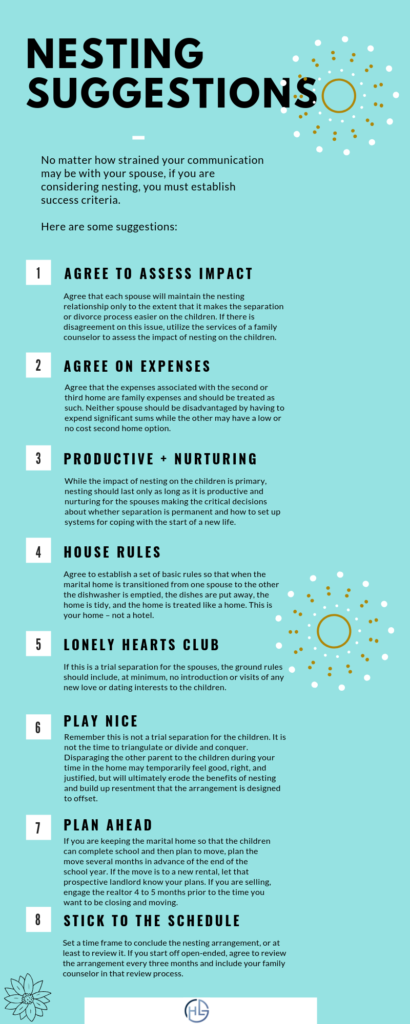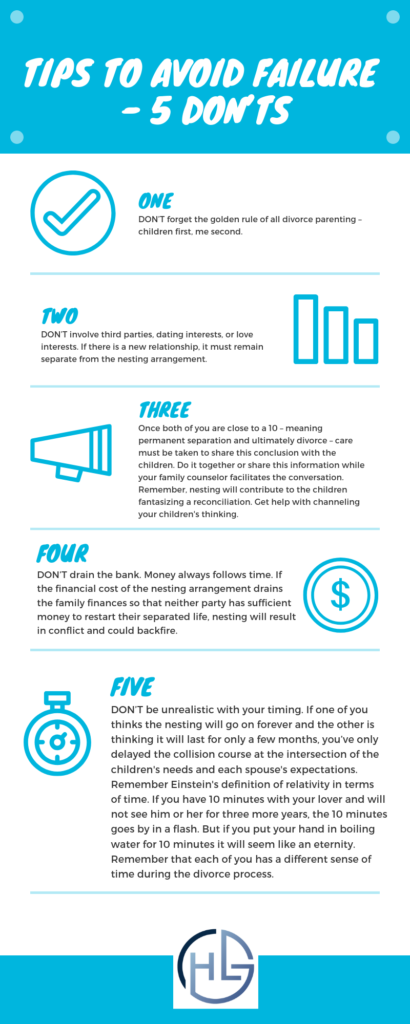
Can It Work for You?
If you have kids, getting divorced is especially tough. In the back of your mind, there’s always the thought that the separation will risk the well-being of the children. The key, perhaps, is to keep it as drama -free and amicable as possible. Keep it child-centric. But how? There’s a custody / parenting arrangement called NESTING which could be the answer.
Nesting is a parenting system that separated or divorced parents use in order to keep children in their primary home and familiar surroundings. Rather than having the children going between two homes, nesting allows the children stay put while the parents alternate coming in and out of the home. Everyone wants to do right by their children in a divorce and exploring nesting may be a viable option. If you want to check out a Hollywood version of nesting, check out ABC’s romantic comedy “Splitting Up Together.” For you and your family, however, consider the arrangement’s purpose, importance, and best results.
What’s the Purpose?
A child-centered approach to your separation or divorce, if shared by your spouse, will give everyone the best chance at a healthy future. This approach can include keeping the children in the marital home for a defined period.
Some examples include the following:
- A child about to graduate can stay in the family home amid the separation or divorce to ensure that the child remains in the school district and graduates with his or her class. This results in less disruption to the child’s daily living during a difficult time.
- A special needs child is better suited to be in the family home as it is already set up to address the child’s needs. Again, the goal and intended result is to have the least amount of disruption as possible.
Many children need to adjust to the idea that their parents will separate or divorce and letting them do so in familiar surroundings may serve their best interests. Done right, nesting can ease the pain of the divorce and transition into two separate homes with new parenting schedules.
A Change In Mindset – Permanent or Temporary?
Nesting may also allow one or both spouses to explore whether the separation is permanent or if there is a reasonable prospect of reconciliation. Trial separation while leaving the children in the home allows a couple that has a chance of bouncing back to do so without experiencing massive economic changes. It is important to have a conversation with your spouse to determine where each of you sit on a scale of 1 to 10. 10 is that you absolutely want a divorce tomorrow and 1 is that you absolutely do not want the divorce. Share your number you’re your spouse through a candid and honest conversation. This conversation is best held in a nurturing counseling environment rather than at a moment of pique.
Budget
Nesting can impact your budget both ways – spending more money than planned managing more than one living environment, or saving some money on housing during the beginning of your separation and divorce.
If you maintain the marital home and each parent needs to get a separate paid residence, the economics may weigh heavily against exploring nesting. If you already have a second home or you have nurturing friends and family who can house you on the cheap for a while, nesting may help the children and help your budget. As soon as you have to create two households, you lose efficiencies.
You may be in a leased property and it may simply not make sense to vacate or break your lease early. Keeping the leased property until the end of the term may be best for your budget and also give you time to figure out whether it is best for you to renew the lease or move on.
For homeowners, there are many decisions that need to be made during a separation or divorce. How much is the house worth? How much do we owe? How would we split up equity? Do we wait for the market of our credit to improve before we sell? You may want to wait out the market for a while since an improving market may result in a significant increase in your net sale proceeds. You may simply need time to figure out what your refinancing options are. Or, maybe you simply need to wait for a better selling season. In the northern United States, spring is viewed as the prime family home selling season. It is ideal to sell your home and close around the end of the school year so that you can be moved in and settled by the beginning of the next school year.
Keeping the home and alternatively occupying it with your spouse may remove some of the mistrust that arises out of many divorces.
What Results are you Looking for?

Tips to Avoid Failure

Tips for Success

Separation and divorce may be part of your family’s journey. Nesting can ease a part of that journey. It is a temporary device that, when managed well – with the proper help and communication skills – can serve your children well and show them a respectful and dignified way to solve big challenges. When the arrangement is used to further bitterness, get revenge against your spouse, or delay the inevitable, nesting will backfire and wind up costing you precious time, energy, respect, and money.

